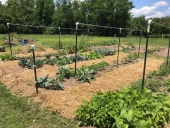location: Lowell, Massachusetts, USA, (zone 6)
History:
When I moved here, half the ground had no living cover, and many of the shrubberies were dead. Last summer there was extreme drought, and I didn't do much because I broke my leg. This summer I planted lots of variety, watered, limed and fertilized. I also added 1 beehive. I added last year's
compost (7 m^3) in hills.
Current conditions: pH is generally 6.5, low nitrogen, high P and K
I intend to keep adding nitrogen fertilizer to fix the low test result. I hope to add horse manure later.
cover crops: clover (red, white, and sweet), small grass seed (timothy, fescues, bluegrass, rye), oats, wheat, winter rye, hairy vetch, peas, lentils, dandelions, soil diver radish, buckwheat, alfalfa, green beans,
flax
Cover crop observations:
I added Buckwheat heavily at first because little else would germinate. Now I don't use much of it because it's bad at surviving. It is very heat and drought tolerant when it's under 3 centimeters. Clovers do well, but won't get tall. Winter rye and hairy vetch are the best, but they both die in the summer. Rye is extremely intolerant of the summer. It needs to be consistently below 75 Fahrenheit to establish rye. Most tall plants die in the summer. I probably should have used Sudan grass.
Crop observations:
Green beans die suddenly, but are the biggest crop. Tomatoes take no effort. They are the second biggest crop, and I didn't intentionally plant them. I don't even eat fresh tomatoes. Potatoes do well. The asparagus that survived my planting mistakes did well.
Cover crop goals:
The soil repels water a bit, so I would like to till more. I would like perennials that till like radish.







